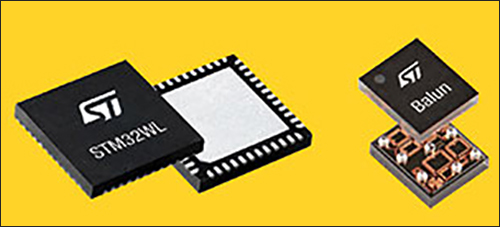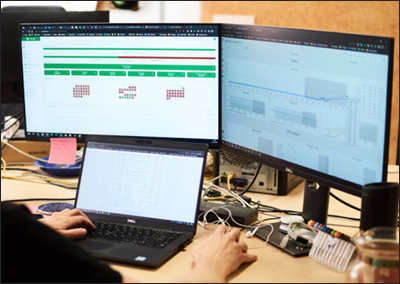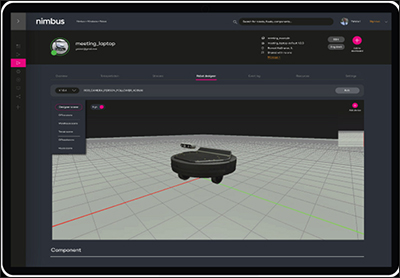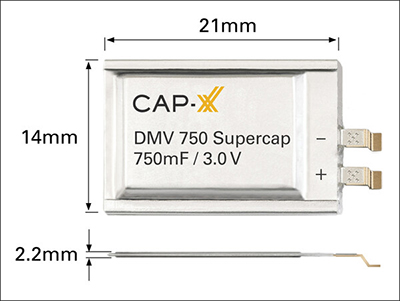Feb 23, 2023RFID Journal LIVE! 2023 will feature end-user companies discussing RFID's use in various industries, as well as exhibitors offering tagging solutions for multiple applications. To learn more, visit the event's website.
- STMicroelectronics Releases RF-Integrated Passive Devices
- Mobix Labs Intros New Ultra-Wideband Antenna
- Sports Vision, Rochester Hospital Deploy Keonn RFID Tech
- Sewio Releases On-Premises Version of myRTLS
- Cogniteam Enables IoT Robot and Sensor Integration
- CAP-XX Offers Prismatic Supercapacitor for IoT Devices
Presented here are recent news announcements in the radio frequency identification and Internet of Things industries.
STMicroelectronics Releases RF-Integrated Passive Devices
STMicroelectronics has released nine RF-integrated passive devices (RF IPDs) with antenna impedance-matching, balun and harmonic-filter circuity optimized for STM32WL wireless microcontrollers (MCUs). The company's STM32WL MCUs combine application-level processing and wireless communication for smart connected devices, with an integrated Arm Cortex-M4 MCU with a sub-GHz long-range radio managed by a Cortex-M0+ core. The radio is LPWAN-compliant, supports multiple modulation schemes, and comes with LoRaWAN and Sigfox stacks included in the STM32CubeWL MCU software package.
 The RF IPDs, packaged as chip-scale devices, connect the STM32WL MCU to its antenna to boost RF performance. Integrating all components on a single die, the company explains, ensures consistent performance and avoids process variations that affect conventional matching networks built with discrete components. A simplified circuit design saves on bills of materials and permits a smaller form factor, making the technology suitable for cost-sensitive, space-constrained IoT devices.
The RF IPDs, packaged as chip-scale devices, connect the STM32WL MCU to its antenna to boost RF performance. Integrating all components on a single die, the company explains, ensures consistent performance and avoids process variations that affect conventional matching networks built with discrete components. A simplified circuit design saves on bills of materials and permits a smaller form factor, making the technology suitable for cost-sensitive, space-constrained IoT devices.
The nine variants let designers choose parameters according to RF frequency range and power, MCU package type, and two- or four-layer PCB. The series comprises the BALFHB-WL-01D3 through BALFHB-WL-06D3 for applications at 868 MHz and 915 MHz, STMicroelectronics reports, as well as the BALFLB-WL-07D3, BALFLB-WL-08D3 and BALFLB-WL-09D3 for 490 MHz. Each device integrates the receive and transmit signal paths between the MCU and antenna.
An integrated filter provides high attenuation of unwanted transmitter harmonics, helping designers satisfy the regulations set by worldwide radio-licensing authorities. All devices are in production now and are offered in a 2.13-millimeter (0.08-inch) by 1.83-millimeter (0.07-inch) eight-bump wafer-level chip-scale package with a profile below 630µm after reflow. They are available now at ST's e-store, starting at 20 cents apiece for orders of 1,000 units.
Mobix Labs Intros New Ultra-Wideband Antenna
 Mobix Labs, a connectivity solutions provider for wireless millimeter-wave 5G and wired high-bandwidth cable networks, has announced the availability of its MOBX1845 ultra-wideband (UWB) antenna. Offered as a standalone product, the circular-polarized, surface-mount antenna is intended for use in a range of applications. These include radar imaging for synthetic aperture and inverse synthetic aperture targeting, UWB communication for satellite navigation, and military surveillance for electronic countermeasure and electronic counter-countermeasures, the company reports.
Mobix Labs, a connectivity solutions provider for wireless millimeter-wave 5G and wired high-bandwidth cable networks, has announced the availability of its MOBX1845 ultra-wideband (UWB) antenna. Offered as a standalone product, the circular-polarized, surface-mount antenna is intended for use in a range of applications. These include radar imaging for synthetic aperture and inverse synthetic aperture targeting, UWB communication for satellite navigation, and military surveillance for electronic countermeasure and electronic counter-countermeasures, the company reports.
"We are excited to start sampling the MOBX1845, the first of several innovative antennas to be introduced that complement our disruptive integrated circuit wireless solutions," said Fabian Battaglia, Mobix Labs' CEO, in a prepared statement. "Configurated for either left- or right-hand circular polarization, this new antenna offers unprecedented performance and quality in a compact-sized package, and expands upon our growing integration in the defense, air and space industries."
With a frequency range of 8 GHz to 45 GHz, the MOBX1845 offers a typical peak gain of +1 dBi per element, the firm indicates, with a beamwidth of 55 to 100 degrees. With a pitch of 14 millimeters (0.55 inch) and an overall size of 60.4 millimeters (2.38 inches) by 15.2 millimeters (0.7 inch) by 7 millimeters (2.78 inches), the MOBX1845 features a microstrip feed that enables simple integration with a printed circuit board.
Sports Vision, Rochester Hospital Deploy Keonn RFID Tech
 Keonn has announced that Sports Vision's flagship store in Belgrade, Serbia, has implemented a suite of Keonn solutions. Hard tags and RFID labels are encoded with the company's AdvanStation-200 workstation, while inventories and goods are monitored via an AdvanScan handheld reader. Two AdvanMirror smart mirrors and three AdvanFitting-200 overhead smart fitting rooms are installed, Keonn reports, and customer-employee interactions are more efficient due to an AdvanServe portable product recommendation system.
Keonn has announced that Sports Vision's flagship store in Belgrade, Serbia, has implemented a suite of Keonn solutions. Hard tags and RFID labels are encoded with the company's AdvanStation-200 workstation, while inventories and goods are monitored via an AdvanScan handheld reader. Two AdvanMirror smart mirrors and three AdvanFitting-200 overhead smart fitting rooms are installed, Keonn reports, and customer-employee interactions are more efficient due to an AdvanServe portable product recommendation system.
 Three AdvanPay-170 RFID readers have been installed at counters, while an AdvanMat RFID floor mat has been situated at the entrance to reduce theft. This project has been managed and integrated by Keonn's partner Princ. The benefits of the implementation, according to Keonn, include unobstructed and inviting entrance, an enjoyable customer experience, the prevention of long queues at checkouts, and fast and accurate inventories, transfers and receptions.
Three AdvanPay-170 RFID readers have been installed at counters, while an AdvanMat RFID floor mat has been situated at the entrance to reduce theft. This project has been managed and integrated by Keonn's partner Princ. The benefits of the implementation, according to Keonn, include unobstructed and inviting entrance, an enjoyable customer experience, the prevention of long queues at checkouts, and fast and accurate inventories, transfers and receptions.
In addition, the University of Rochester Medical Center has installed RFID technology in its mobile healthcare units for orthopedic surgeries. The system displays patients' identities, medical records and allergies, along with the length of surgical procedures, when cleaning occurs between operations, and the correct placement of a cart with surgical tools to avoid dirt and bacteria. This project was managed and installed by Silent Partner, with Keonn's AdvanReader-160 readers, as well as Advantenna-SP11 and Advantenna-SP12 antennas, installed in the hospital's surgical rooms.
Sewio Releases On-Premises Version of myRTLS
 Sewio, a UWB-based real-time location system (RTLS) vendor, has announced the general availability of an on-premises version of its myRTLS Care subscription services and software. The myRTLS Care package, the company reports, consists of software that monitors the system and provides crucial alerts, with proactive support services and a hardware warranty to ensure smooth, long-time operations and minimal downtime.
Sewio, a UWB-based real-time location system (RTLS) vendor, has announced the general availability of an on-premises version of its myRTLS Care subscription services and software. The myRTLS Care package, the company reports, consists of software that monitors the system and provides crucial alerts, with proactive support services and a hardware warranty to ensure smooth, long-time operations and minimal downtime.
Sewio offers RTLS solutions for manufacturers, warehouses, distribution centers and OEMs. Its UWB system comes with RTLS Studio remote management and visualization software. The on-premises version of myRTLS Care allows companies from regulated industries that prefer on-premises solutions over cloud-based systems to leverage more than 15 features that monitor system health and alert users to disruptions.
"As real-time location systems now support mission-critical industrial use cases, becoming the backbone of the process flow, the reliability of the system has become pivotal," said Milan Simek, Sewio's CEO, in a prepared statement. "A significant portion of our industrial customers prefer to run all pieces of their system on their own infrastructure under the full control of their IT team. Allowing them to add myRTLS care to their stack offers them even greater control and peace of mind."
Cogniteam Enables IoT Robot and Sensor Integration
Cogniteam, a NVIDIA partner and the creator of the Nimbus platform for developing, deploying, managing and performing remote updates, has announced a new capability to develop and manage the robot, along with its Internet of Things (IoT) environment. This, the company indicates, means a 60 percent faster time to prototype and allows for more reliable Internet of Robotic Things (IoRT) devices, which have been developed using Nimbus's library of field-deployed software components.
 According to Cogniteam, industries that rely on autonomous robots (healthcare facilities, hotels and sensitive environments, for example) must consider operational challenges caused by external factors, such as humans walking in a robot's path, or unexpected high-traffic areas. To address such problems, software and hardware engineers code communication protocols and develop standards that can be understood by both IoT and IoRT devices, but typically not on the same platform.
According to Cogniteam, industries that rely on autonomous robots (healthcare facilities, hotels and sensitive environments, for example) must consider operational challenges caused by external factors, such as humans walking in a robot's path, or unexpected high-traffic areas. To address such problems, software and hardware engineers code communication protocols and develop standards that can be understood by both IoT and IoRT devices, but typically not on the same platform.
This opens up the potential for errors due to software misalignment, or to unknown disturbances between independent development platforms, which can be catastrophic for autonomous robots operating in mission-critical roles. Thus, Cogniteam has bolstered its Nimbus system to manage the full lifecycle process for standalone IoRT devices, IoRT fleets and IoT devices. The software components now include packets for IoT companies along with their communication protocols, provided in a drag-and-drop format.
"Successful robot deployments demand a single development platform for both the machine and facility integrations," said Yehuda Elmaliah, Cogniteam's co-founder and CEO, in a prepared statement. "Bringing both the robotic and environmental IoT device development under one roof opens exciting new opportunities for beginner through advanced developers."
In medical labs or sensitive facilities. sensors can be programmed alongside the robot, allowing it to better sense the autonomous device and clear a path for it to reach its destination. "This is a major step in integrating robots in a shared human space," added Eliahu Khalastchi, a Cogniteam research scientist, in the prepared statement. "We're training robots to read social cues and act in a more predictable and natural manner when on the street or in a facility, completing its mission while naturally interacting with humans."
CAP-XX Offers Prismatic Supercapacitor for IoT Devices
CAP-XX, a manufacturer of prismatic, cylindrical and lithium-ion supercapacitors, has unveiled its DMV750 2.2-millimeter (0.09-inch) prismatic 3V supercapacitor to provide high performance for IoT, medical and other space-constrained and mission-critical electronic devices. Samples of the product are now available for $4.95 to $15 apiece, depending on the quantity ordered.
 This multi-purpose supercapacitor can support common 3V coin-cell batteries to extend its life and functionality, according to the company. It can replace a bulky 3V cylindrical supercapacitor to save design space, as well as replace batteries when micro-energy harvesting can extract enough solar, vibration, RF or other environmental energy to charge the supercapacitor in sustainable, batteryless devices.
This multi-purpose supercapacitor can support common 3V coin-cell batteries to extend its life and functionality, according to the company. It can replace a bulky 3V cylindrical supercapacitor to save design space, as well as replace batteries when micro-energy harvesting can extract enough solar, vibration, RF or other environmental energy to charge the supercapacitor in sustainable, batteryless devices.
With 23 percent more energy than a 2.7-volt supercapacitor in the same size package, the 3V DMV750 device provides high peak pulse power to enable either batteryless or more battery-efficient applications, CAP-XX reports. It measures 21 millimeters (0.8 inch) by 14 millimeters (0.6 inch) by 2.2 millimeters (0.08 inch), and it can operate at temperatures ranging from -20 degrees to +85 degrees Celsius (-4 degrees to +185 degrees Fahrenheit).
"It's estimated that over five billion 3V coin cell batteries and 12 billion IoT devices are sold annually," said Anthony Kongats, CAP-XX's CEO, in a prepared statement. "While not all devices require a supercapacitor, many would benefit from our powerful DMV750 supercapacitor to store and release the energy needed for peak power functions like data transmission… Our DMV750 ultra-thin 3V supercap provides engineers with multiple options to overcome power delivery challenges in space-constrained, mission-critical, sustainable electronic devices."

